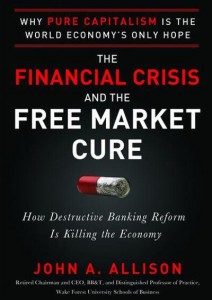The Financial Crisis and the Free Market Cure: Why Pure Capitalism is the World Economy’s Only Hope, by John Allison. New York: McGraw-Hill, 2012. 320 pp. $28 (hardcover).

Imagine how great it would be to have your own inside tour guide to the modern financial crisis, someone able to comment on the crisis not as an onlooker, but as the leader for two decades of one of America’s strongest financial institutions.
Imagine no further. Your guide is John Allison, former CEO of Branch Banking & Trust Corporation (BB&T), and his fee for the tour is the cost of his new book, The Financial Crisis and the Free Market Cure.
Although numerous others have outlined the basic causes of the mortgage meltdown—the easy-money policies of the Federal Reserve, the Community Reinvestment Act and similar regulations, hazardous lending spurred by Fannie Mae and Freddie Mac, and the federal government’s “too big to fail” policies—Allison offers an in-depth, insider’s perspective on these policies. He also discusses a variety of other, subtler ways that government policy created and worsened the financial crisis, giving his book a depth unmatched by other popular works on the topic.
Allison does not limit his discussion to the political and economic causes of financial crisis; he also discusses the broader philosophical and cultural causes of both this crisis and the loss of economic liberty more broadly.
The deepest cause of the crisis, argues Allison, is philosophical. The morality of altruism—the morality of self-sacrifice for others or the “common good”—he says, leads to unprincipled action and “the ‘free lunch’ mentality” (p. 218). Against the morality of altruism and its political consequence of statism, Allison eloquently defends “each individual’s moral right to his own life” and “to the product of his own labor” (p. 219).
Allison demolishes the notion that “deregulation” of the financial industry somehow caused the mortgage crisis. “Financial services is a very highly regulated industry, probably the most regulated industry in the world” (p. 5), he explains; and he proves the point in chapter after chapter, example after example.
In chapter 4, for instance, Allison reviews how federal regulators, motivated by flawed studies alleging to show discrimination, forced banks to issue riskier loans. He shows that regulators interpret and enforce their rules selectively—depending on political pressures, their own incentives, and the perceived short-term health of the economy—and how they block or encourage mergers as they see fit.
In chapter 8, he explains that the federal government approves a select few rating companies and that these few utterly failed to foresee the impending risks. Part of the problem, says Allison, is that the SEC compelled these rating firms to be “paid by issuers—bond sellers, not bond buyers,” creating “serious conflicts of interest” (p. 83).
In chapter 9, Allison points out that FDIC deposit “insurance” encouraged “pick-a-payment” mortgages that helped put countless homeowners “under water” in their homes.
In chapter 11, he discusses how the SEC-sanctioned Financial Accounting Standards Board imposes absurd accounting standards that cause banks to act irrationally.
And in chapter 13, he discusses such intrusive and destructive federal regulations as the Privacy Act, Sarbanes-Oxley, and the Patriot Act. “Government regulations,” summarizes Allison, “suck the energy and will of the best and brightest” (p. 147) while rewarding the incompetent and irresponsible.
On the whole, Allison achieves his objectives admirably, explaining key aspects of the financial system, the government policies primarily to blame for the mortgage crisis, and the deeper cultural and philosophical issues in play and at stake.
The book does, however, have a few flaws worth mentioning. It puts forth some contradictory positions, contains some confusing formulations, occasionally bogs down in arcane minutiae, and suffers from poor organization.
For instance, although Allison touts his book as advocating “pure capitalism,” several of his positions stray from that standard. He says he opposes antitrust laws, but he also argues that if certain “companies are too big to fail (and the government regulators and the rating agencies do believe it), they should be broken up” (p. 174). Rather than unequivocally calling for phasing out Social Security, Allison writes, “If a pure opt-out is not politically acceptable, privatization could result in individuals having a fixed [i.e., a mandatory] saving rate” (p. 200). Rather than consistently advocating open immigration and an end to welfare, Allison writes, “Assuming that the welfare system will not be fixed, immigration will need to be controlled” (p. 206). Rather than calling for an end to the coercive wealth transfers known as unemployment benefits, Allison writes that they “should” be limited to “90 days, or 6 months at the maximum” (p. 212).
Examples of confusing or contradictory formulations include Allison’s insistence that “spending on housing is consumption, not investment”; “[w]e live in a house, and therefore we consume the house” (p. 9). Although Allison here points to an important distinction between investment and consumption, his formulation fails to account for the many instances in which people purchase houses or apartments precisely for investment purposes—for instance, to renovate and sell or to rent for profit. In his introduction, Allison describes “greed” as “a desire for the unearned” (p. 2); later, however, he writes that “the proper definition of greed is the aggressive pursuit of anything,” so it can therefore be good (p. 101). After condemning self-sacrifice as an evil of the altruist morality (p. 216), Allison suggests that parents should “make a financial sacrifice” to educate their children (p. 234).
As to the occasionally arcane terminology in the book, perhaps someone with a deeper background in finance than I have can nimbly synthesize it. But I found his commentary on “CDO2s” (p. 124), “‘naked’ shorts” (p. 127), and a few other apparently technical matters to be mystifying. Chapter 11, regarding fair-value accounting, is particularly dense for the lay reader.
To indicate some of the book’s organizational problems, consider that the first four pages of chapter 14 contain six variants of the phrase, “as previously discussed.” My guess is that Allison easily could have cut thirty pages from his book had he discussed each point forcefully and concisely once, rather than continually repeating earlier points while introducing new points.
Another organizational problem is evident in chapter 23, which is supposedly about “How the United States Could Go Broke.” In addition to inexplicably devoting the chapter’s third paragraph to foreign policy, Allison devotes most of the space not to the entitlement programs and massive spending that are breaking the country, but to the problems of leftist ideology in the universities and ineptitude in government-run K–12 schools.
Most of these flaws are writing issues, which could and should have been caught by an editor. And, fortunately, the general content of the book is good enough and important enough to warrant high recommendations and wide readership nonetheless.
The fact that Allison is primarily a banker, not a writer, is precisely what makes his book so valuable. Whereas others cite examples from newspapers, interviews, and the like, Allison offers lengthy descriptions of how his own bank acted to weather the financial storm, and of how he and other bankers were coerced and cajoled by government regulators.
For those wanting a deep understanding of the causes of the financial crisis, the government’s destructive response to it, and the capitalist solution, The Financial Crisis and the Free Market Cure offers a wealth of fascinating insights adding up to a forceful case for free markets.


![[TEST] The Objective Standard](https://test.theobjectivestandard.com/wp-content/uploads/2017/10/logo.png)














